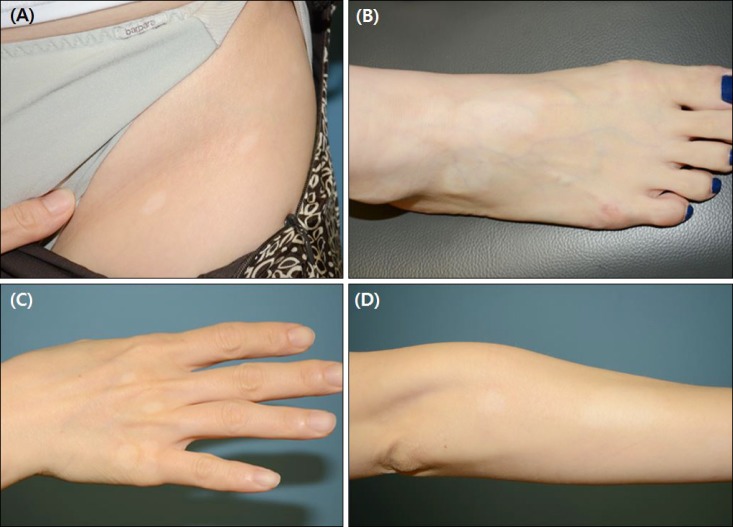Dear Editor:
Adalimumab is a complete human monoclonal anti-tumor necrosis factor α (anti-TNFα) that is generally well tolerated. With increasing use of adalimumab and other anti-TNFα therapies, several cutaneous adverse events have been reported during the therapy, including immune-mediated skin lesions1. A 39-year-old woman who had an 11-year history of Crohn's disease and was treated with adalimumab (40 mg administered subcutaneously every other week) presented at our clinic with multiple achromic macules and patches on the extremities (Fig. 1). The lesions developed abruptly about 12 months after the initiation of adalimumab therapy. The diagnosis of vitiligo was made after the patient's skin turned blue under a Wood's lamp. Laboratory tests were also performed to check for other autoimmune conditions, including thyroid disorders, and no abnormality was diagnosed. The patient denied any family history of vitiligo. She has been treated with a combination therapy of excimer laser and topical tacrolimus without stopping the adalimumab therapy for about 1 year, and has shown minimal response thus far.
Fig. 1. Multiple well-demarcated irregularly shaped depigmented macules and patches (A) on the left proximal thigh, (B) dorsum of the right foot, (C) dorsum of the right hand, and (D) right forearm.
The role of anti-TNFα inhibitors in the development of vitiligo is complicated and contradictory. There have been several case reports that showed improvement in vitiligo in patients receiving anti-TNFα therapy for other diseases2. The therapeutic effect of anti-TNFα inhibitors on vitiligo might result from stopping the physiological effect of TNFα on melanogenesis. Concretely, it has been reported that TNFα decreases the level of tyrosinase, a rate-limiting enzyme in melanin biosynthesis in vitro3. The melanocytotoxic effect of TNFα in vitiligo has also been demonstrated2. On the contrary, anti-TNFα inhibitors have been associated with the development of a considerable number of autoimmune diseases such as vitiligo, as well as leukocytoclastic vasculitis, systemic lupus erythematosus, psoriasis-like lesions, and alopecia areata1. Several theories were proposed to explain the mechanisms underlying the development of autoimmunity during treatment with anti-TNFα inhibitors. In vivo, nucleosome numbers (major autoantigens released during apoptosis) increase in patients receiving anti-TNFα therapies. This could lead to the subsequent induction of autoantibodies4.
To our knowledge, only two cases of vitiligo have been attributed to adalimumab use. The first case was that of newly developed vitiligo after 8 months of adalimumab therapy for Crohn's disease; this was similar to our case5. In the second case, there was rapid deterioration of vitiligo within 3 months of adalimumab therapy for managing ankylosing spondylitis4. In our case, it could not be determined whether vitiligo was caused by adalimumab therapy or if it developed in association with Crohn's disease because the concomitant occurrence of vitiligo with inflammatory bowel disease has been rarely reported. The long duration of Crohn's disease, and the sudden onset and rapid spreading of cutaneous lesions support the former possibility.
Previous reports and our case suggest that anti-TNFα agents, including adalimumab, can induce vitiligo development. Dermatologists should be aware of this possibility for an earlier detection and treatment of vitiligo in patients receiving anti-TNFα therapy.
References
- 1.Exarchou SA, Voulgari PV, Markatseli TE, Zioga A, Drosos AA. Immune-mediated skin lesions in patients treated with anti-tumour necrosis factor alpha inhibitors. Scand J Rheumatol. 2009;38:328–331. doi: 10.1080/03009740902922612. [DOI] [PubMed] [Google Scholar]
- 2.Simón JA, Burgos-Vargas R. Vitiligo improvement in a patient with ankylosing spondylitis treated with infliximab. Dermatology. 2008;216:234–235. doi: 10.1159/000112932. [DOI] [PubMed] [Google Scholar]
- 3.Martínez-Esparza M, Jiménez-Cervantes C, Solano F, Lozano JA, García-Borrón JC. Mechanisms of melanogenesis inhibition by tumor necrosis factor-alpha in B16/F10 mouse melanoma cells. Eur J Biochem. 1998;255:139–146. doi: 10.1046/j.1432-1327.1998.2550139.x. [DOI] [PubMed] [Google Scholar]
- 4.Maruthappu T, Leandro M, Morris SD. Deterioration of vitiligo and new onset of halo naevi observed in two patients receiving adalimumab. Dermatol Ther. 2013;26:370–372. doi: 10.1111/dth.12002. [DOI] [PubMed] [Google Scholar]
- 5.Posada C, Flórez A, Batalla A, Alcázar JJ, Carpio D. Vitiligo during treatment of Crohn's disease with adalimumab: adverse effect or co-occurrence? Case Rep Dermatol. 2011;3:28–31. doi: 10.1159/000324619. [DOI] [PMC free article] [PubMed] [Google Scholar]



